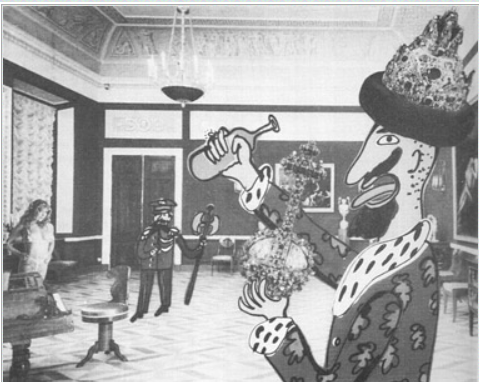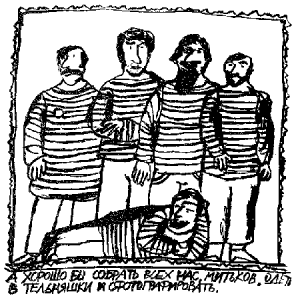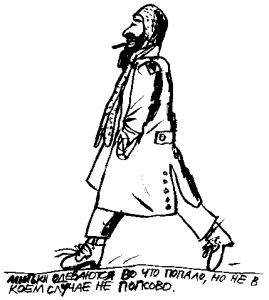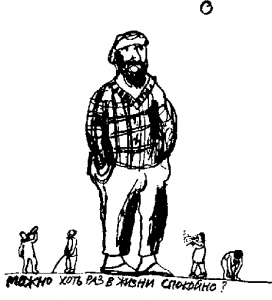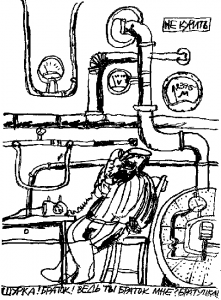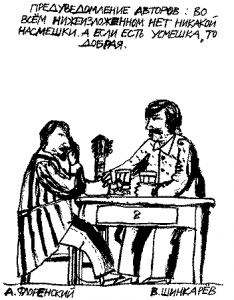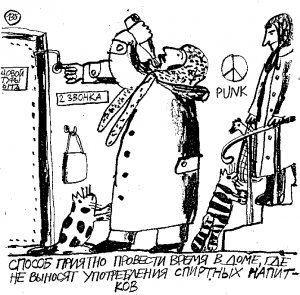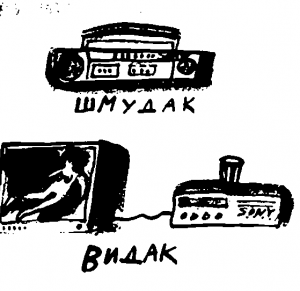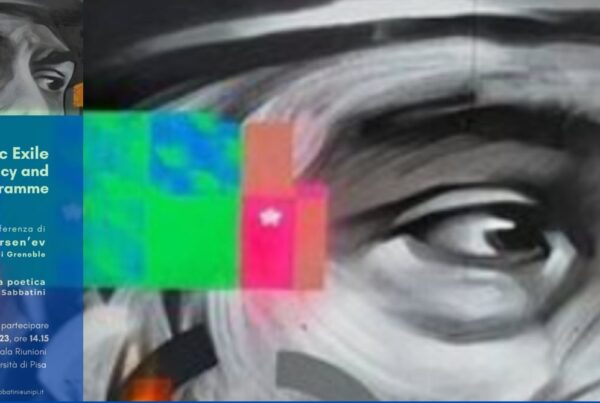Title of the film:
Mit’ki nikogo ne khotiat pobedit’, ili Mit’kimaier [Mit’ki don’t want to defeat anyone, or Mit’kimaier]
Directed by: Anatolii Vasil’ev
Screenplay by: Vikor Tikhomirov, Vladimir Shinkarёv
Art direction by: Aleksandr Florenskii
Music by: Boris Grebenshchikov
Production company: Troickii most – 48 Chasov
Country: Russian Federation
Year: 1992
* cartoons from the book Mit’ki (1990).
Description:
The Mit’ki appeared in Leningrad in the second half of the 1980s, where they immediately made a name for themselves as one of the most eccentric groups on the city’s underground art scene. In addition to the founders, the non-conformist artists Dmitrii Shagin, Vladimir Shinkarёv, Aleksandr Florenskii, Ol’ga Florenskaia and Viktor Tikhomirov, the group included poets, writers, and musicians, such as Boris Grebenshchikov, Kostantin Kuzminskii, Viktor Tsoi, Aleksei Khvostenko and many others.
The distinctive features of the group were the tel’niashka, the traditional striped sailor shirt, which became an un-official uniform, and a tendency to combine elements from a variety of artistic fields. Their aesthetic principles were steeped in everyday life and fuelled by alcohol. The groups’ non conformist attitude soon made its members legends. The group was active until 2008, when Vladimir Shinkarёv publicly announced its end; his book Konec Mit’kov (The End of the Mit’ki) was published in 2010.
Versatility and a propensity for hybridising literature and audiovisual media characterised Mit’ki from the beginnings, evident, for example, in the eight-part work Mit’ki, written and published in Samizdat between 1984 and 1990 by Vladimir Shinkarёv, and the stop-motion animation film Mit’ki nikogo ne khotiat pobedit’, ili Mit’kimaier (Mit’ki don’t want to defeat anyone, or Mit’kimaier) directed by Anatolii Vasil’ev in 1992 and inspired by Shinkarёv’s book. Three of the movement’s most representative themes are highlighted in these parallel works: the aesthetics of failure, alcoholism and sex.
In Mit’ki, Vladimir Šinkarёv’s traces for the first time the grotesque caricature of his ‘bratushka’ Dmitrii Shagin, frontman of the movement, whose nickname gave the group its name (Dmitrii’s father, Vladimir Shagin, a member of the of the Leningrad Aref’evcy circle, called him Mitja or Mit’ёk as a child).
The uniqueness and originality of the Mit’ki lies in their attempt to transform everyday existence into an aesthetic project: ordinary life overlaps inextricably with the creative world, and the boundary between the two realities becomes increasingly blurred, almost indistinguishable. It is precisely this dualism that underpinned the works of the Mit’ki until the last days of the movement.
The Mit’ki were the creators of a new, composite language, enriched with film quotations, exclamations, interjections, and neologisms, that characterised their speech and filtered into their writing. For example, very frequent in the mit’kovian oeuvre, are the affectionate nicknames ‘bratushka’, ‘sistrënka’, the exclamations ‘ëlki-palki’ and the neologism ‘shmudak’ to designate “electronic devices manufactured outside of Russia” that contains the unflattering word for an incompetent or emasculated man (mudak), which itself derives from the term mudé denoting male genitalia (cf. Michajlovič 2018: 88).
The written work Mit’ki, the movement’s manifesto and bible is divided into eight parts and combines words and images to create a collage of linguistic experiments which includes grotesque anecdotes, lists of behavioural rules, descriptions of alcoholic rituals and cartoons.
Mit’ki nikogo ne khotiat pobedit’, ili Mit’kimaier was the first experimental stop-motion animated feature film made by the group. The post-modern film was directed by Anatolii Vasil’ev, with a screenplay co-written by Shinkarёv and Viktor Tikhomirov. The set design and art direction were by Aleksandr Florenskii and the music by Boris Grebenshchikov, legendary leader of the rock band Akvarium, who wrote the songs Shinkarëvskii romans (Shinkarёv’s Romance) and Serdce (Heart), released on his 1996 album Chubchik (Bangs), for the film.
Although the nine-chapter film is closely related to Russian-Soviet realia and faithful to mit’kovian humour, on a formal level, it is similar to the experimental animated short movies of the Monty Python group, in particular to the first stop-motion animated short film Story Time made in 1968 by Terry Gilliam.
The animated film Mit’kimaier uses a variety of animation techniques – cut-out animation, using paper cut-outs photographed in sequence to create the illusion of movement; found footage, reusing previously filmed material in new contexts; and captions which recalls the works of the avant-garde – which are presented in rhythmic alteration to the viewer.
The film’s protagonist is the American millionaire Mister Maier, who, after reading Shinkarёv’s book Mit’ki, renounces his capitalist existence and wealth to move to Russia and become a mit’ёk.
The definition “aesthetics of failure” was coined by the scholar Aleksandr Mikhailovich, author of the monograph “Mit’ki” i iskusstvo postmodernistskogo protesta v Rossii (Mit’ki and the art of post-modernist protest in Russia) first published in the US in 2018 and in Russian in 2021.
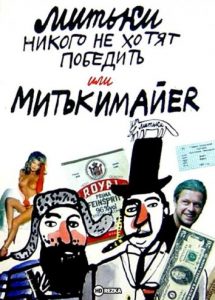
Poster of the animated film “Mi’ki nikogo ne khotiat pobedit’ ili Mit’kimaier” (1992).
The Mit’ki often present viewers/readers with an anti-hero whose qualities either contrast or parody the patriotic ideals associated with official representations of Soviet heroism. This story of the mit’ёk who attempts to rescue a woman from drowning despite being unable to swim is emblematic of the Mit’ki’s conception of the ridiculousness of misplaced heroism. The mit’ёk dies because he ignores a primordial instinct for self-preservation. In the film version of the anecdote, the mit’ёk is one of three characters who undertake the feat, the others being an American and a Frenchman. Each would be rescuer is introduced by a montage of stereotypical images from their home countries, depicting heads of state, money, writers, and pop icons with additional information provided by a narrative voice and captions.
In both the book and the film, the ship’s captain cries out “Zhen’shchina za bortom! Kto spasët zhen’shchinu?” (Woman overboard! Who will save the woman?) creating a moment of suspense and anticipation, which is deflated by the episode’s tragicomic denouement.
The second theme to permeate the mit’kovian universe is alcohol and its surrounding cult, a strong driving force for all the group’s members, at least until the early 1990s, when the founders decided to get sober.
In the chapter of the book entitled Pochemu mit’kovskaia kul’tura poka ne idёt semimil’nymi shagami (Why the civilisation of Mit’ki does not yet make great strides), it is stated that alcohol is the only possible reason for quarrelling in the group’s idyllic existence.
Alcohol, however, played a contradictory role in the group’s dynamics: on the one hand, it was a possible source of contention, but on the other, it was a peacemaker as described by Aleksandr Florenskii in his meeting with Anatolii Vasil’ev, director of Mit’kimaier: “… Anatolii Vasil’ev was sent to rescue me, an excellent animator, but with totally different aesthetic visions. We almost went our separate ways, then it turned out we had something in common: a love for alcohol. And that is how we got along” (cf. Princeva, Sandalov, Semendiaeva 2014).
Drinking represented an heroic gesture of protest against Soviet power, especially during Gorbachёv’s anti-alcohol campaign. In the short film Nostal’giia (Nostalgia) from 1991 included in Mit’kimaier, images of labels of alcoholic drinks from the Stagnation period flit across the screen accompanied by slow, sad music, symbolising the group’s nostalgia for the bottle.
Alcohol was part of the Mit’ki’s artistic identity and generated a great many of the myths and anecdotes relating to the group. When the founding members stopped drinking, many fans felt the group’s image had been compromised and its credibility undermined. Unable to separate the fictitious characters from their flesh-and-blood creators, many followers abandoned their heroes.
The third and final theme of sex is closely linked to alcohol and is also present in much of the mythology surrounding the Mit’ki. The group’s members claimed to be asexual – “so much so that they boast about it” (cf. Shukan 1990: 51) – even though they were married and had children. Although sex does not seem to have been a priority, the subject is presented in the seventh chapter entitled Mit’ki i seks (Mit’ki and sex).
On commenting on the relationship between the group’s founding principle of brotherhood (bratstvo) and sex, Shinkarёv states that “relations between men and women almost inevitably go through a sexual phase and thus generate marriages, tragedies, etc. (…)” (cf. Ibid.: 45). He goes on to say that therefore, the mit’ёk, in order to preserve the exclusive relationship of a brotherhood, “transfer libido to something else” (cf. Ibidem.).
Sex appears to have been perceived as a threat to the fraternal principles governing the group and, for this reason, inevitably took a back seat. Gender divisions within the group appear to have been rather marked; the term mit’ёk referred to men, while women such as Ol’ga Florenskaia, active from the very beginning of the movement, were defined as ‘sestrënki’.
In the Mit’ki’s world, women, particularly wives, seem to have been destined to take care of the family, as well as everything else, while men, free from the duties of everyday life, were at leisure to drink and ‘fraternise’. This division is consistent with the Mit’ki’s conception of the hero, which does not reflect traditionally held collective beliefs, and with their apparent total disinterest in sexual relations.
In the fragment published on the official website of the Mit’ki entitled Alkogol’ i seksual’noi zhizni mit’kov (Alcohol and the sexual life of the Mit’ki) (cf. Shuliakhovskaia 1992), the fundamental role assumed by alcohol in the group’s sex lives is emphasised. Indeed, “the eroticism of the mit’ki is directly linked to alcohol. Some Mit’ki systematically stop drinking. And so, their erotic life also vanishes” (cf. Ibidem.).
Marta Capossela
[31st December 2022]
Translation by Marta Capossela
Bibliography
- Asenin S., Mir mul’tfil’ma: idei i obrazy mul’tiplikacii socialisticheskikh stran, Iskusstvo, Moskva 1986.
- Capossela M., “Mit’ki nikogo ne khotiat pobedit’, ili Mit’kimaier”. Ob èkranizacii knigi “Mit’ki” Vladimira Shinkarëva, “Memoirs of NovSU”, 40, 1 (2022): 110-114.
- Caramitti M., Letteratura russa contemporanea: la scrittura come resistenza, Laterza, Bari 2010.
- Iocca F., Mit’ki, in C. Pieralli, M. Sabbatini (eds.), Voci libere in URSS. Letteratura, pensiero, arti indipendenti in Unione Sovietica e gli echi in Occidente (1953-1991), Firenze University Press, Firenze 2021-, <vocilibereurss.fupress.net>.
- Mikhailovich A., “In the Heat of the Boiler Room”: The Subculture of the Russian Navy in St. Petersburg’s Mit’ki Group, “World Literature Today”, 80, 4 (2006): 50-57.
- Mikhailovich A. The Mitki and the Art of Postmodern Protest in Russia, University of Wisconsin Press, Madison 2018.
- Mikhailovich A., “Mit’ki” i iskusstvo postmodernistskogo protesta v Rossii, NLO, Moskva 2021.
- Mit’ki nikogo ne chotjat’ pobedit’, ili Mit’kimajer. https://www.youtube.com/watch?v=hybEBNWtZmY , online (last accessed: 31/12/2022).
- Piccolo L., I mit’ki, “Russica Romana”, XI (2004): 149-157.
- Piretto G. P., Quando c’era l’URSS. 70 anni di storia culturale sovietica, Cortina Raffaello, Milano (2018): 534-536.
- Princeva A., Sandalov F., Semendiaeva M., Kratkaia istoriia mit’kov: 30 let bratushek i sestrenok, “Afisha Daily”, 17 febbraio 2014. https://daily.afisha.ru/archive/vozduh/art/kratkaya-istoriya-mitkov-30-let-bratushek-i-sestrenok/ , online (last accessed: 31/12/2022).
- Sabbatini M., Leningrado underground. Testi, poetiche, samizdat, WriteUp, Roma 2020.
- Shukan G. (ed.), Mit’ki, opisannye Vladimirom Shinkarëvym i narisovannye Aleksandrom Florenskim, SP “SMART”, Sankt-Peterburg, 1990.
- Shinkarëv V., Konec Mit’kov, Amfora, Sankt-Peterburg, 2010.
- Shinkarëv V., Mit’ki, “T8 Izdatel’skie Technologii”, Sankt-Petersburg – Moskva, 2020.
- Storytime – Terry Gilliam (1968). YouTube. https://www.youtube.com/watch?v=OY8gc-j_QmY , online (last accessed: 31/12/2022).
- Shuliakhovskaia N., Alkogol’ v seksual’noi zhizni mit’kov. “Mit’ki” Official Site (1992). http://mitki.kulichki.com/sex/ , online (last accessed: 31/12/2022).
To cite this article:
Marta Capossela, Mit’kimajer. About the film adaptation of “Mit’ki” by Vladimir Shinkarëv, in Voci libere in URSS. Letteratura, pensiero, arti indipendenti in Unione Sovietica e gli echi in Occidente (1953-1991), a cura di C. Pieralli, M. Sabbatini, Firenze University Press, Firenze 2021-, <vocilibereurss.fupress.net>.
eISBN 978-88-5518-463-2
© 2021 Author(s)
Content license: CC BY 4.0
